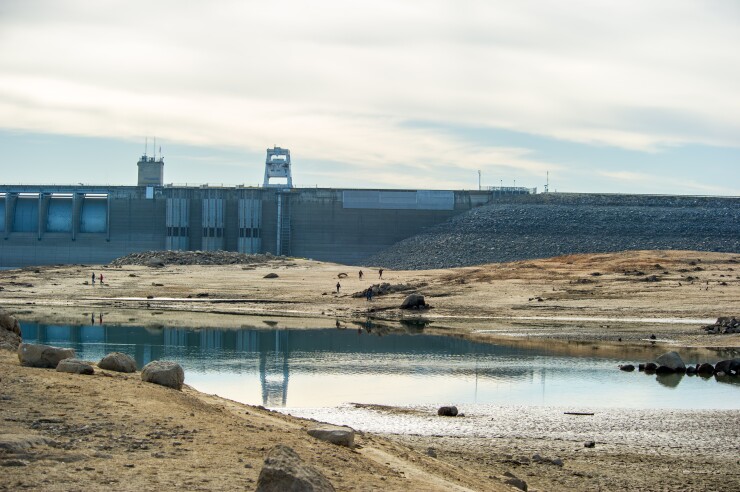Four Twenty Seven, a Berkeley, California, company that developed software to track climate change risks for private companies, wants to help bond investors evaluate the risks to cities and counties.
Focusing on climate change-based economic risk analysis, the company created a software application using data to model the risks for cities and counties after it received a request from Breckinridge Capital Advisors, a fixed-income fund manager.

“Many of us think that climate change is the greatest socioeconomic danger out there and that there is a need for markets to understand the risks,” said Emilie Mazzacurati, founder and chief executive officer of Four Twenty Seven.
She founded the firm five years ago with the aim of using climate change forecasting models to help companies understand the potential physical impacts on their assets and how to prepare for natural disasters, Mazzacurati said.
“We had done a lot of work on the risks for equities and real assets – and expanded our work after we discovered a large demand from fixed income investors,” Mazzacurati said.
The company’s first clients were large corporations with hundreds of facilities.
The firm expanded its offerings two years ago when investment companies became interested in the potential impact on companies in their portfolios. A few months ago, that expanded again to modeling the risk for municipalities.
“Climate risk is increasingly a part of our credit analysis for municipal issuers across the country,” said Andrew Teras, senior analyst at Breckinridge, in a statement. “The climate risk scores developed by Four Twenty Seven provide a comparable way to evaluate climate exposure and will give us another factor for assessing our investment universe.”
Though the bond rating agencies are increasingly integrating climate risk into their municipal ratings, they lack concrete metrics that compare and assess how cities and counties are exposed to specific hazards, according to a
Four Twenty Seven provides local climate risk scores that provide comparable, forward-looking data to fill this gap, Mazzacurati said.
“Each city and county is assigned a score based on how it ranks nationwide, which provides investors with comparable detail to complement the assessments of credit rating agencies,” according to the report.
The firm took global climate change models used by international research institutions and created a set of scores for U.S. cities and counties above a certain population, she said.
The software application created by Four Twenty Seven processes trillions of bytes of data boiling it down to a few characteristics, she said. For instance, the firm can compare flooding problems in various counties and rank them on a risk basis.

The report outlines the firm's approach to measuring exposure to climate hazards and pinpoints the cities and counties most exposed to the impacts of climate change.
“This new dataset provides a comprehensive suite of risk scores to better inform ratings and pricing decisions,” Mazzacurati said. “The risk scores will be very helpful for all market participants, including muni bond investors, local governments, and ratings agencies.”
The research targets five major climate categories: cyclones and hurricanes, sea level rise, extreme rainfall, heat stress, and water stress. It covers all 3,143 U.S. counties and 761 cities with populations over 50,000 as of 2015.
“This fits squarely in the realm of information that the market wants to know – including us,” said Kurt Forsgren, an S&P Global Ratings analyst.
Four Twenty Seven appears to be the first to release this sort of data, but there are other companies with similar efforts that are trying to provide such information down to ZIP codes, Forsgren said.
“As a market participant, we recognize there are credit risks associated with changes in the environment,” Forsgren said. “We would be a consumer of this information. Much as we look at long-term forecasts of financials and look at engineering reports to form credit views, we would be very interested in this information.”
S&P and Moody’s Investors Service both released reports in 2017 explaining their methodologies for incorporating climate change into their municipal credit ratings. Fitch Ratings just released a report Tuesday explaining its approach.
“Our earlier piece recognized that the muni market has had risks like this for years. There have always been hurricanes,” Forsgren said. “What is different is that we are getting more, and better information, of what those risks are, and we have begun to see what the exposures are if those risks are not addressed.”
The rating agencies all consider financial management, planning and the economic diversity of the municipalities in their approaches.
But in the absence of forward-looking climate projections, the estimates used by the rating agencies “may grossly underestimate the magnitude of future risks, or at least fail to characterize the type of climate risks that may eventually make it more difficult for a municipality to meet its financial obligations,” according to the firm’s report.
Moody’s published a report in November listing six indicators it uses "to assess the exposure and overall susceptibility of U.S. states to the physical effects of climate change." For instance, the indicators included the share of economic activity for the states that comes from coastal areas or homes located in a flood plain.
Fitch Ratings analysts wrote that they consider environmental factors in their credit ratings through the lens of a fundamental credit risk. Fitch also noted that “the federal government approved $130 billion in aid for natural disasters last year, a considerable 0.7% of the country's $19.7 trillion economy.”
Fitch analysts said they don’t anticipate such a scenario, but added that if the federal government pulled back on its current level of aid it would be a credit negative for cities and counties.
The federal government's role in disaster response is critical in mitigating natural disaster risk for ratings on state and local governments," said Michael Rinaldi, a Fitch senior director.
With the exception of Hurricane Katrina and flooding in Louisiana, rating actions directly linked to climate change or natural disasters have historically been limited; but the kind of damage to vital infrastructure and widespread depopulation that occurred during Katrina have become more commonplace, most recently with the hurricanes that struck the southeast last year, Fitch said.
In addition to providing information to rating agencies and investors, the company’s analysis can also help municipalities better prepare for natural disasters, said Nik Steinberg, Four Twenty Seven's director of analytics.
Every region of the country has unique vulnerabilities to weather-related disasters, according to the report.
The coastal areas with the highest exposure to problems from rising sea levels are the San Francisco Bay Area, the Pacific Northwest, New Jersey and Virginia in the mid-Atlantic region and North Carolina and Florida.
The Southeast has the greatest exposure to risk from cyclones and hurricanes, which tend to be less frequent and weaker in the mid-Atlantic and Northeast.
The Midwest has the greatest exposure to heightened flood risk due to changing rainfall patterns.
Drought and the potential for wildfires falls in the “water stress” category – a condition expected to worsen in the Southwest, Pacific Northwest and Western Pacific.
Eight major cities in California could face downgrades in the absence of water supply alternatives and sustained cutbacks in use, according to the report.
Key watersheds for agricultural production such as the Central Valley aquifer system in California and the Ogallala Aquifer in the Great Plains are highly exposed to water stress.
The agriculturally dominated areas of Bakersfield, Delano, and Visalia, California, along the Central Valley Aquifer are among the ten cities most exposed to water stress. Similarly, municipalities along the Ogallala Aquifer in the Great Plains also rely heavily on agriculture and are among the most exposed to water stress.
The Southeast and the Midwest, concentrated in Missouri and western Illinois and fanning out to the Great Plains, Mississippi River Basin and Florida, have the greatest exposure to heat stress.
Rising temperatures pose “serious risks to the nation’s energy infrastructure and labor force,” according to the report.
The highest heat stress scores in the report tend to be centered in the Southeast and Midwest, concentrated in Missouri and western Illinois and then fanning out to the Great Plains, Mississippi River Basin, and Florida. The desert Southwest and agriculturally dominated counties in the Sacramento Valley and southeastern Washington State also had high heat scores.
Extreme temperatures grounded flights in Phoenix last July and could drive up energy costs for car manufacturers that have moved to Missouri, according to the report.





